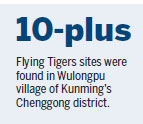Large cluster of Flying Tigers relics found
By Li Yingqing in Kunming (China Daily) Updated: 2017-08-05 07:01
Experts studying the history of the Flying Tigers in China said they have discovered the largest and most concentrated cluster of relics sites related to the legendary US volunteer air squadron, which helped China fight Japanese invaders during World War II.
More than 10 sites were found in Wulongpu village of Chenggong, a district of Kunming that is more than 30 kilometers from downtown Kunming, according to Sun Guansheng, director of the Yunnan Flying Tigers Research Institute.
The sites include the remnants of the Flying Tigers Command, its encampment and the Chenggong airport, built between 1940 and 1941 for their use, he said.
The experts also found a facility near the Chenggong airport that was used to store gasoline, bombs and machine-gun bullets.

The findings were made thanks to years-long efforts including on-site investigations, talks with witnesses and checks of memoirs and documents by a team of experts, led by Sun, from the Yunnan Flying Tigers Research Institute and the Yunnan Flying Tigers Museum.
"The discovery is of important historical and cultural value, and these relics sites are testimony to the friendship and cooperation between the Chinese and US people," Sun said.
All the relics sites lack proper protection, Sun said, adding that funds and policy support are urgently needed to protect the sites.
The Flying Tigers, the American Volunteer Group led by General Claire Chennault, harassed the Japanese forces from the air from August 1941 to July 1942.
The pilots, all former members of the US Army Air Corps, Navy or Marine Corps, participated in more than 100 battles, shooting down 272 Japanese aircraft and destroying another 225 on the ground. The group left China in 1944.
Historical documents showed that the headquarters in Wulongpu received 110 pilots, 150 machinists and support staff in December 1941.
The area where the relics are located is now used by Yunnan Qiushi Wood Products Co, which acquired the right to use the land and started production of wooden products in 2011.
Xiong Guiping, who is in charge of the company's operations, said the company has little capability to help protect these relics.
"We have moved workers from the three rows of cottages that used to be the air squadron's dormitories, but a large sum of money would be required to repair and maintain these old houses," she said.
Some of the relics sites have been seriously damaged, Sun said. For example, the Flying Tigers' Command had been used as a pigsty for years.
He said he hopes the cluster of relics can be developed into an international cultural tourism area to promote the history of the Flying Tigers.
Zhang Yi contributed to this story.
liyingqing@chinadaily.com.cn
(China Daily 08/05/2017 page1)
- 'Cooperation is complementary'
- Worldwide manhunt nets 50th fugitive
- China-Japan meet seeks cooperation
- Agency ensuring natural gas supply
- Global manhunt sees China catch its 50th fugitive
- Call for 'Red Boat Spirit' a noble goal, official says
- China 'open to world' of foreign talent
- Free trade studies agreed on as Li meets with Canadian PM Trudeau
- Emojis on austerity rules from top anti-graft authority go viral
- Xi: All aboard internet express











